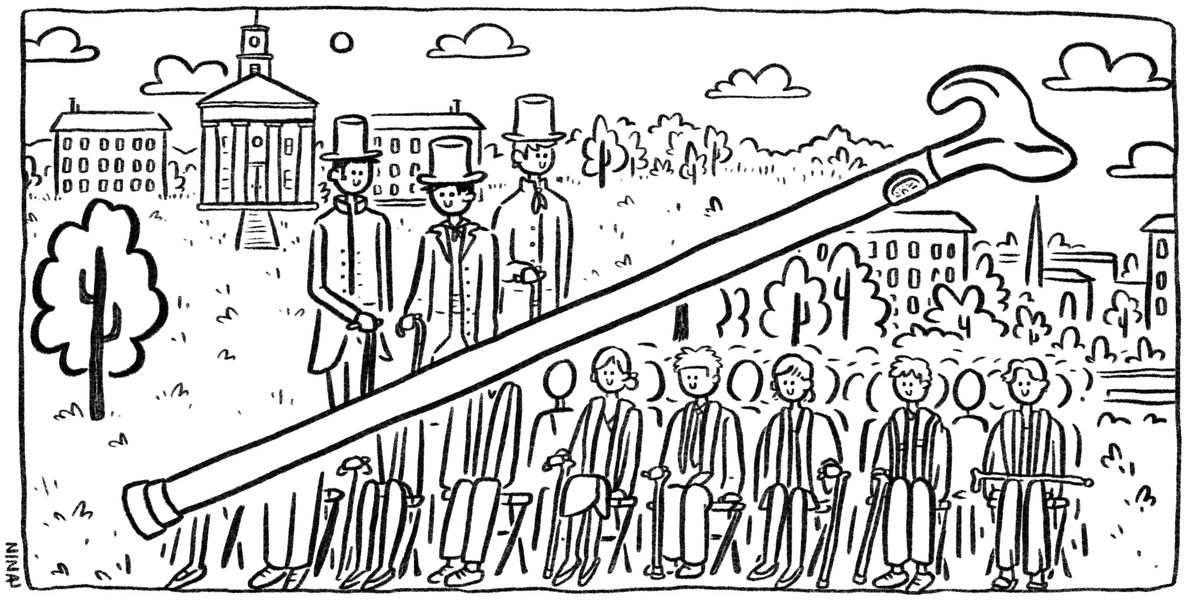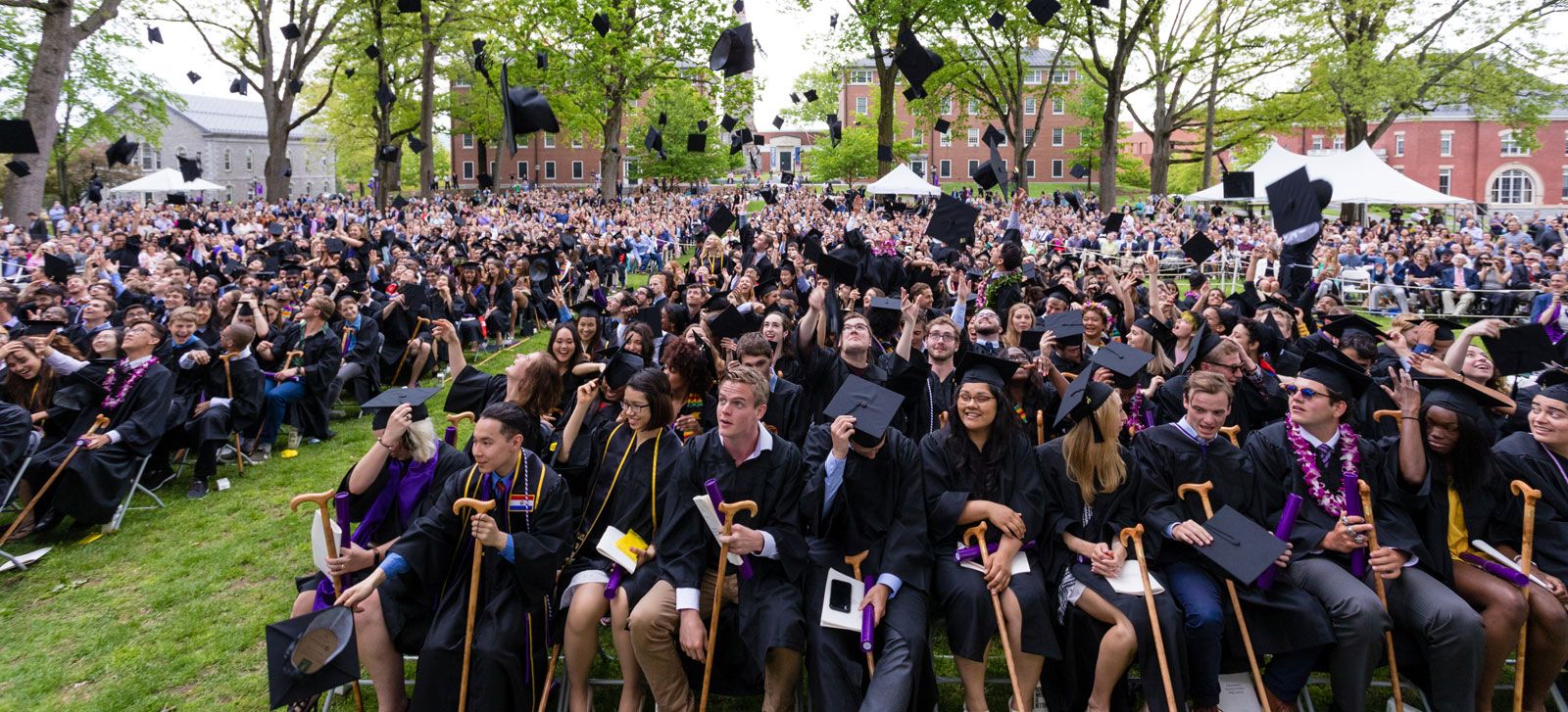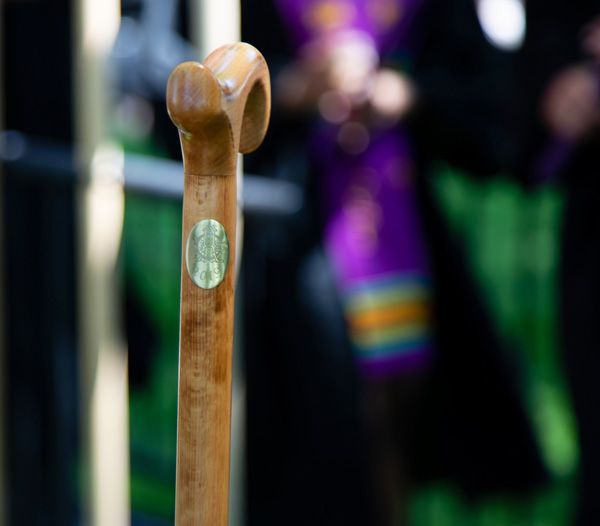A Gift to the Graduates: The Revival of Conway Canes
Conway Canes, gifted to all graduates at Commencement, are one of the few traditions that encompass all students. It took collective effort from students, alumni, advancement officers, and manufacturing companies to ensure that the canes became a lasting part of Amherst history.

Speakers, caps and gowns, and many, many tears and hugs — most college and university commencements all look the same. But the scene of Amherst’s graduation looks a little different: The sea of graduates is filled with hundreds of beechwood walking sticks. These Conway Canes, named after Brian Conway ’80 and Kevin Conway ’80, who endowed the tradition, have been handed out at every Commencement since 2003, and even extend to the ceremonies for students who graduate in the middle of the school year.
According to the college’s website, “the Conway Canes serve as an enduring symbol of the graduates’ connection to their class and their alma mater.”
Conway Canes are one of the few traditions that exist on campus for all students. And it took collective effort from students, alumni, advancement officers, and manufacturing companies to ensure that the canes became a lasting part of Amherst history.
History
It started with students.
José Abad ’03 visited a friend at Bryn Mawr College and heard about their traditions, including Lantern Night, where sophomores would present freshmen with lanterns at the end of the school year.
“I was like, ‘Wow. That’s really cool. I wish Amherst had something like that, that we would give out,’” Abad said.

At that time, few traditions existed at Amherst. The only one Abad could remember was The Amherst Party (TAP), a weekly party centered on a keg of beer. (The AAS is reviving the tradition this school year after a six-year hiatus.)
Abad, along with his friends Ben Baum ’03 and Siona van Dijk ’03, were members of the Student Activities Committee of the Friends of the Amherst College Library, an alumni organization that fundraised for the Frost Library and promoted its events.
They spent a lot of time in the archives, and it was there they discovered a tradition-worthy idea.
“We had all stumbled across the existence of this old tradition at Amherst from the 19th century,” Baum said. “The freshmen were forced to wear these little hats that denote they were freshmen but when you finally moved on to your sophomore year, you graduated from your hat to something better and you got a cane.”
“The three of us came up with this idea that this would be a really fun thing to revive in a new form that maybe had greater meaning for the modern day,” Baum explained. The original tradition was a form of hazing, but in their new iteration, canes would have a more positive message. Instead of being a symbol of upperclassmen elitism, canes would be a gift at graduation.
“It was going to represent your Amherst education, something that supports you through your life,” Abad said.
According to a 2003 press release, Abad, Baum, and van Dijk “enlisted the aid of Friends of the Amherst College Library, the Association of Amherst Students, the Office of Alumni and Parent Programs and the Office of the President to purchase canes” for the first year.
Once they secured funding, the three students got to work to make the canes a reality. Baum found a company in Germany that would both produce the canes and toast the wood so it would look more like those from the 19th century.
Baum went to Holyoke to visit a metal manufacturing company that, incidentally, produced brass signs for Tiffany & Co. They ordered metal plaques that had Tiffany-style embossing, their class year (2003), and an emblem of “A.C.” for Amherst College that they found from a 1901 Glee Club program in the archives.
“The idea at the time was that every class would design their own logo that goes on [the plaque on the cane],” Baum said. “This was the one we had chosen for our class, but classes in the future would be able to pick their own. And that was part of the tradition from the 19th century.”
(While the Class of 2004 did select a different logo, a 19-century theater program “A.C.,” the canes’ plaques eventually reverted back to the original Glee Club emblem, with the only changes being to class year.)
The plaques had an “adhesive, and so, we’d lined them up on these, like huge tables that were at the college archives, and we had like a little bit of like a sticking party,” Abad recalled. They affixed about 400 plaques onto the canes.
When other students heard about the new tradition, they thought it was funny at first.
“We got a bemused reaction … I probably got teased a little bit for it … I was a history major. It was very in character for me to be really excited about something like this,” Baum said. “But then people thought it was really cool.”
“It became like this kind of instant, defining moment of graduation,” Abad said.

Uncertainty
Even though people loved the canes, its future was not always certain. Former Chief Advancement Officer Megan Morey explained that the college helped fund the first year of the canes with the understanding that at some point, permanent funding would be needed. However, until 2010, there was no stable source of funding.
In 2004, an anonymous donor agreed to fund the canes. But there was a catch: He would only fund it if 500 people went to a men’s hockey game against Tufts University.
In 2004, Lauren Wong ’04 told The Amherst Student that the condition “helped get school spirit going.” The donor also funded activities and giveaways to get students to show up.
In the end, more than 500 people attended the game, and the donor funded the Class of 2004’s canes. But no permanent funding source was found, leaving the tradition in a precarious position. Donors were found on a year-to-year basis, so it remained possible for the new tradition to disappear as fast as it had emerged.
In 2010, Morey asked the Conways, twin brothers who went to Amherst, if they would like to endow the canes tradition.
“Brian was on the Board [of Trustees] and they were both very generous,” Morey said. “I knew that they appreciated this kind of stuff.”
“My brother Brian and I were very happy to help support a tradition that is meaningful to the school and its students,” Kevin Conway wrote in a message to The Student. “Megan knew that we have deep respect for traditions that bond communities together, and would be interested in making sure the canes remained a part of the ritual and tradition of Commencement at Amherst.”
The Fund for College Canes was created, the canes were dubbed the Conway Canes, and the tradition’s future was secured. Since it was an endowment, the funding for the canes will not end.
“The initial gift is invested and grows and we only spend a certain percentage of what comes from that growth every year, and the college sets that level,” Current Chief Advancement Officer Betsy Cannon Smith explained. “That’s the beauty of an endowed gift … it makes a way for us to have long-term support of a program long into the future because we’re not spending [the original gift’s amount]. We're using what is growing from that fund and spending no more [than] 4.5 percent of the earnings” in recent years.
The Value of Tradition
Over the years since 2003, the canes have only become more important to Amherst’s sense of community. Mid-year graduation ceremonies now have canes, and even some alumni who graduated before the tradition was resurrected have made their own for reunions.
“We all come from such different places. We’re about to leave to such different places,” Abad said. “We have something that we all kind of share and continues that long-term relationship where everybody has an anchor. Keeping our relationships at least metaphorically intact with a physical essence.”

“I’ll see Christmas cards from people where they’re holding their canes,” Cannon Smith said. “I’ve had the chance to give the canes out many times at Commencement, to stand there as the students come off the stage and then hand them their cane. And I cannot tell you the number of students who said ‘I’ve been waiting for this for years.’”
The canes “adapt our history to modern times and to not lose it entirely but to change it into something new,” Baum said. “I think that that has a lot of meaning to people.”





Comments ()